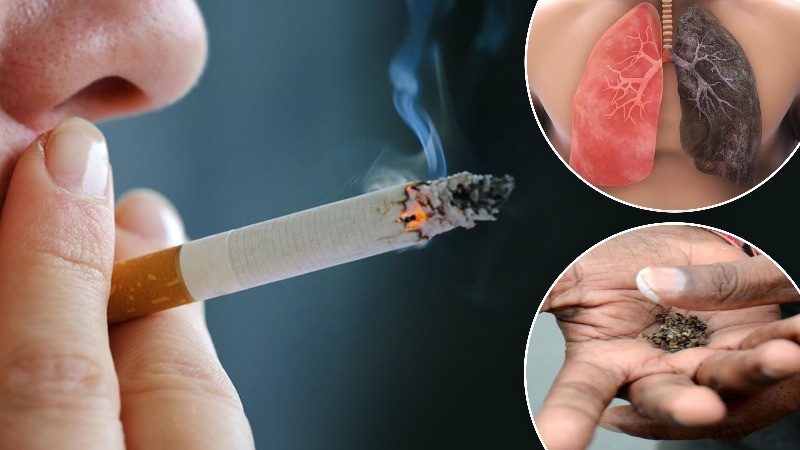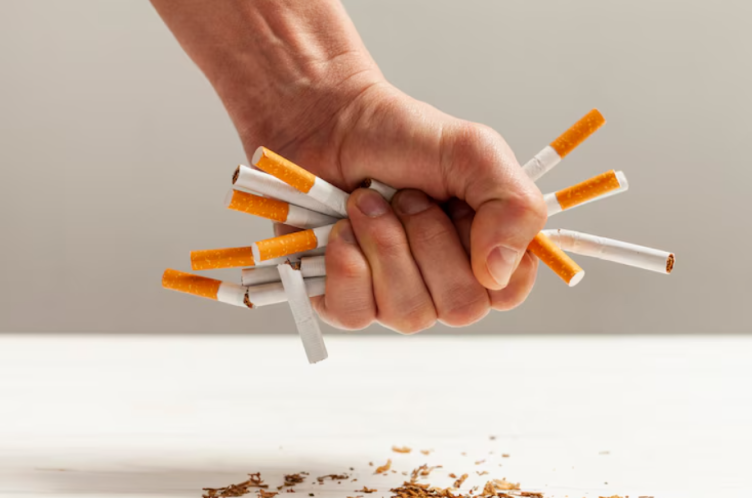
Beware! We have another pandemic slowly gripping the world with its deadly venom: The tobacco pandemic, taking over the health, wealth, and goal of sustainable development. Tobacco is widely consumed in India and worldwide, posing a major challenge to health as well as the economy. It causes nearly 3.8 million deaths globally (according to the WHO in 2020). Currently, India is the world's second-largest tobacco producer as well as consumer, not even sparing the younger generations. A GLOBOCAN report of 2023 indicates a 57.4% spike in cancer cases in India in 2040, as compared to 2020. The country is burdened with smoking and smokeless tobacco. Despite declining cases with regulatory effects, tobacco consumption is a deepened risk within the roots that harms the health of individuals as well as the ones near and dear to them.
Before we follow up on Newstrack Infomedia's upcoming detailed conversation with the National Chairman of the IMA Cancer & Tobacco Control Committee, Dr. Dilip Kumar Acharya, here is a look at Tobacco consumption in India, its forms and use, and harmful effects, reasons for tobacco use, campaigns, and policy in India, a focus on Madhya Pradesh with the formation of MP Tobacco Free Alliance, how to quit tobacco, and at the end what concerns everyone: Why is tobacco sold?
_68495dbf0796e.jpg) Most people in India consume tobacco by chewing, ie, in the smokeless form
Most people in India consume tobacco by chewing, ie, in the smokeless form
Forms and Use: Tobacco is used in various forms: Smoke and Smokeless. In its smoke form, tobacco is inhaled through bidis and cigarettes. Other prominent ways include cigars, hookahs, and pipes.
The most prevalent form of tobacco consumption in India is smokeless, which includes betel quid chewing. People opt for khaini, gutka, pan masala, and zarda among others.
Additionally, people are exposed to secondhand smoke, which is the smoke inhaled when someone else is smoking around. It claims nearly 1.8 million lives globally. There is also a growing trend of consuming heated tobacco products, which produce aerosols that contain nicotine and other toxic chemicals.
The reasons: There is not a single factor as to why a person consumes alcohol. It can be social and psychological:
Well, socially, tobacco consumption has become culturally normalized and accepted, especially in urban regions. Smoking is considered to be a very cool thing, which drives adolescent groups to engage in it. With the influence one has, there is a high chance of them developing similar habits and attitudes.
Psychologically, it is the tendency to consume a substance frequently. There is a physical dependency to have it at any cost, which is addiction, when it becomes a person's mental or emotional dependency.
Harmful effects on health: It starts with symptoms like trouble sleeping, anxiety, or hunger with cravings, and the urge to consume tobacco. Further causing restlessness, reduced focus and concentration, headaches, ulcers, irritability, grouchiness, resulting in sadness and depression.
Tobacco consumption is a major reason behind cause of non-communicable diseases. It leads to various cancers, cardiovascular and respiratory diseases (coronary heart disease and lung cancer). As many as 1.35 million deaths are caused every year in India due to tobacco use, which is a 1/3rd of the total fatalities in the country[1].
Not only this, but tobacco causes long-term effects on health, which reduce life quality and productivity.
Is it really a stress buster or a coping mechanism?
Tobacco contains nicotine, which releases endorphins, dopamine, and other hormones. These generate feelings of pleasure and happiness, and soon a person becomes addicted to them. As it gives them a feeling of happiness, they find it as a coping mechanism for post-traumatic stress disorder, bad mood, and anxiety that they can use whenever they need.
 Strict community intervention is necessary for tobacco control in India (Image source: VHAI.org)
Strict community intervention is necessary for tobacco control in India (Image source: VHAI.org)
According to the National Family Health Survey (NHFS-5 between 2019 to 2021), there has been a decline in Tobacco consumption in India. The percentage of tobacco usage in men was recorded as 25.4% in urban areas and 36% in rural areas. While in women, the rate was 3.3% in urban regions and 6.5% in rural regions. While it declined in other states of India, the number was high in Bihar, Goa, Gujarat, Himachal Pradesh, and Sikkim.
To curtail tobacco consumption in India, the government runs Nationwide campaigns and programmes for awareness against tobacco consumption:
National Tobacco Control Programme (NTCP): NTCP was launched by the Ministry of Health and Family Welfare in 2007-08. Its objective is to spread awareness against tobacco and its harmful effects, along with the effective implementation of tobacco control laws. The NTCP trains, informs, monitors, and coordinates the organizations, people, and institutions associated with the initiative. It is a three-tier structured programme that functions to the bottom, at the district level[2].
Tobacco Free Campaign (2.0): To protect the Indian youth from tobacco addiction, the Ministry of Health and Family Welfare launched the second edition of the Tobacco Free Campaign in 2024. The campaign aims to protect the health and well-being of the youth from the harmful effects of tobacco.
Public smoking was banned in India in 2008, under the Cigarette and Other Tobacco Products Act (COTPA), 2003, which laid for the nationwide smoking ban in the country. The rule was named the Prohibition of Smoking in Public Places Rules, 2008.
Until recently, in 2019, the Government of India banned e-cigarettes (vapes), under the Prohibition of Electronic Cigarettes Act. These are battery-operated devices that heat a nicotine liquid, creating aerosol that users inhale. The ban was to curb the vaping addiction among the youth of the country.
Approval and follow-up of international conventions and the agendas decided. This targets tobacco packaging, advertising, promotion, and trade practices.
The Tobacco control initiatives are further carried out at a grassroots level by the District Tobacco Control cells, so that there is an effective implementation and monitoring that strengthens the functioning at the bottom. Under the NTCP, there is also a provision for the setting up of Tobacco Cessation services in districts.
Through the myGOV platform, the Center has also initiated a No Tobacco-Free pledge for the citizens that motivates and encourages them.
Furthermore, there has to be an enhanced focus on reducing tobacco consumption rates and achieving effective outcomes in community health. There has to be an increase in tobacco taxes, programmes for school-based tobacco use, and strict community intervention for tobacco control.
_68495f58737f8.jpg) Dr. Dilip Kumar Acharya is the National Chairman of the Cancer & Tobacco Control Committee of IMA, elected for the role for the second consecutive time
Dr. Dilip Kumar Acharya is the National Chairman of the Cancer & Tobacco Control Committee of IMA, elected for the role for the second consecutive timeThe Indian Medical Association's Cancer and Tobacco Control Committee works for tobacco control in India, organizing campaigns and carrying out initiatives throughout the year to spread awareness against tobacco consumption, also ensuring that the message reaches out to the younger generations. Dr. Dilip Kumar Acharya, who is a Consultant Surgeon in Indore, Madhya Pradesh, currently serves as the National Chairman of IMA (Indian Medical Association) Cancer & Tobacco Control Committee, elected for the second consecutive time.
The seed for the formation of the Committee was planted long ago in 2010. Dr. Dilip Kumar Acharya became its Chairman in 2014, working tirelessly for tobacco eradication in the country. With the committee, Dr. Acharya also ensures that the tobacco control and awareness message reaches other countries. He has led the delegation to Canada, Malaysia, Abu Dhabi, and Ireland, among others.
Madhya Pradesh: Initiatives and role in National Tobacco Use
Madhya Pradesh was the first state of India to ban the sale of gutkha (a chewing tobacco product). The State Government has carried out various initiatives and policies against tobacco consumption, playing a major role in the National Tobacco use. Some of these are:
The Cigarettes and Other Tobacco Products (Prohibition of Advertisement and Regulation of Trade and Commerce, Production, Supply and Distribution), Madhya Pradesh Amendment Act 2023, ensures there is a strengthened tobacco control in the state, targeting hookah bars. It banned their operation, stating it as a cognizable offence as well as defining penalties for violation of the same.
Through the State Tobacco Control Cell (STCC) and the District Tobacco Control Cells (DTCC), the MP Government ensures there is a complete implementation of provisions laid under the COTPA 2003.
Various awareness initiatives are carried out by organisations like the Voluntary Health Association of India (VHAI) and the newly formed Madhya Pradesh Tobacco Free Alliance.
After the ban on gutkha in 2012, there has been a significant fall in overall consumption of the product throughout the state.
However, there is still a need for improved health initiatives, more effective policy measures, along with regular assessment of their implementation, among others.
Apart from the State Government's campaigns and initiatives, it also follows the guidelines of the Center. Further, taking steps to ensure that the Center's policies reach out to the grassroots.
Here is a brief about the recently launched Madhya Pradesh Tobacco Free Alliance initiative in Madhya Pradesh:
The Madhya Pradesh Tobacco-Free Alliance is a voluntary, non-governmental, and inclusive platform. Individuals and organizations from the medical, academic, and administrative divisions of society have joined hands to form this organisation, ensuring tobacco control in society. With one accord, Dr. Acharya has been chosen as the convenor of this alliance, which aims to promote awareness regarding tobacco consumption, reinforce anti-tobacco initiatives, protect youth from the dangerous trap, seek strict policy making in this direction, and facilitate grassroots reach of action.
 Get out of the nicotine grind, quit tobacco now (Image source: Freepik)
Get out of the nicotine grind, quit tobacco now (Image source: Freepik)
When you quit tobacco, your oxygen levels become normal again, with reduced risk of heart attack, lungs begin functioning better, and with all of this, your healthcare expenditure also decreases. Nicotine withdrawal isn't easy. Tobacco addiction can be as powerful as addiction to substances like alcohol and cocaine. But it can be controlled and freed from:
Firstly, it has to be the inner voice that says it is time to quit. Then, it is the family and close ones under whose influence and care one opts to quit.
Primarily, one can start with nicotine chewing gum, which is effective in quitting tobacco, reducing craving. Further helping with the withdrawal of dependency on nicotine.
If it doesn't, an individual must move ahead with counseling and medication to receive step-by-step guidance and support for quitting tobacco.
However, there are times when people start consuming tobacco again, despite quitting. This becomes an extremely tough situation to deal with. But, one must follow the post-quitting process as suggested by the doctors and counselors, so that this kind of situation doesn't occur.
If tobacco is hazardous to health, as dangerous as it can claim lives, why is it sold? Why doesn't any Government or authority prohibit its sale? Even if they impose bans, these things are sold somehow or the other across borders. A primary reason is that the sale of tobacco is a major source of revenue for the government. On the other hand, lakhs of people are dependent on the tobacco industry for their livelihoods, right from plucking tobacco leaves to cigarette manufacturing. Waking up one fine day and putting a complete stop to this is not possible.
However, the Government is trying to promote the agriculture of other crops. Despite various regulatory efforts, we also need stricter policies, efficient taxation, and more initiatives in public health. Until then, let's wait to see if we are ever able to witness a tobacco-free India or a tobacco-free world someday.